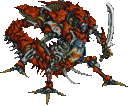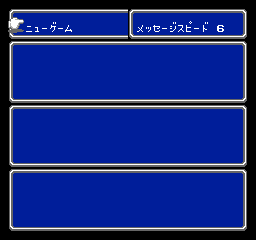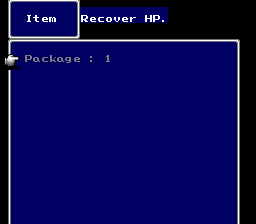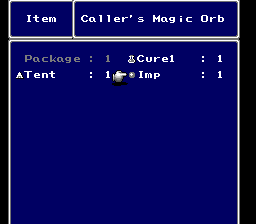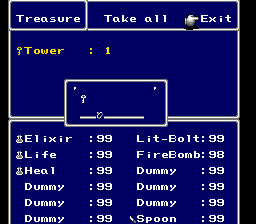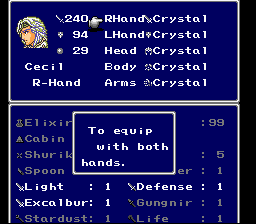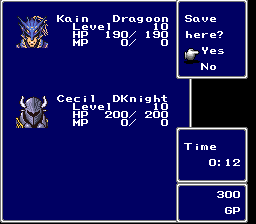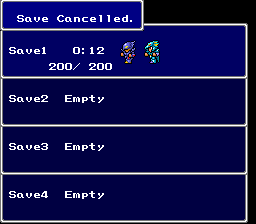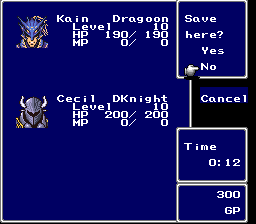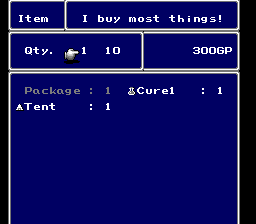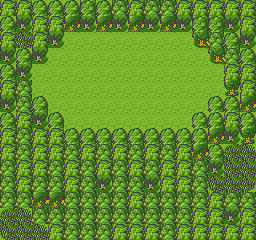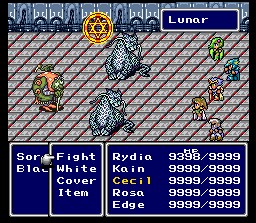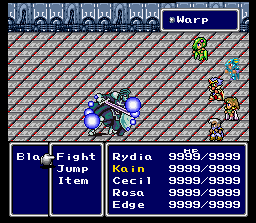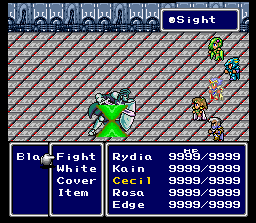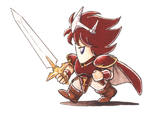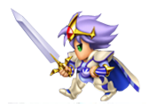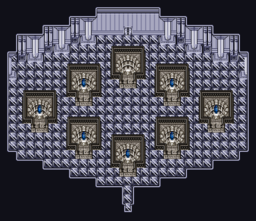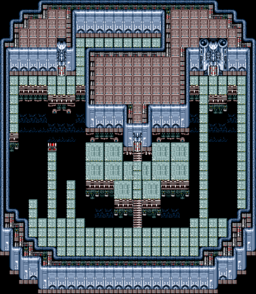If you appreciate the work done within the wiki, please consider supporting The Cutting Room Floor on Patreon. Thanks for all your support!
Final Fantasy IV (SNES, PlayStation)
| Final Fantasy IV |
|---|
|
Also known as: Final Fantasy II (US SNES)
|
| This page is loooong... Consider grouping related content into additional subpages to ease readability. |
Final Fantasy IV marked the series' debut on the Super Famicom after three games on the Famicom. It had somewhat of a convoluted release history, initially released in the US as Final Fantasy II on the SNES (the renumbering a result of the second and third Famicom games being skipped over for the NES). The US version, which featured a reduced difficulty level among other adjustments, would then serve as the basis for Final Fantasy IV Easy Type, a Japan-only revision that features the same reduced difficulty with even further adjustments.
The game would later be ported to the PlayStation, with this version being given a worldwide release with its original numbering and difficulty level intact this time.
Contents
- 1 Sub-Pages
- 2 Unused Graphics
- 3 Unused Items
- 4 Unused Commands
- 5 Unused Text
- 6 Unused Character
- 7 Unused Monsters
- 8 Unused Maps
- 9 Unused Events
- 10 Unused Handedness Behavior
- 11 Oddities
- 11.1 Enemy Evasion
- 11.2 Elemental Physicals
- 11.3 Holy/Dark Relationship
- 11.4 Reflect Oddities
- 11.5 Mist Village's Eastern Entrance
- 11.6 Battle with Yang
- 11.7 Paladin Cecil's Older Design
- 11.8 Kain's Transforming Airship
- 11.9 Cid's Equipment
- 11.10 Daggers
- 11.11 Cross in the Field
- 11.12 Rydia Learns Cure2
- 11.13 Tower of Bab-il Leftovers
- 11.14 "Rare" Underworld Encounters
- 11.15 Sylph's MP Cost
- 11.16 Dark Matter
Sub-Pages
| Prerelease Info |
| Version Differences Easy Type, Hard Type, Soft Type? |
Unused Graphics
![]()
A chanting animation for Kain which is never used. He never gains magic at any point in the game, nor does he, unlike other magic-less characters (Yang, Edward, Cid), have any sort of special skill that would require the use of these frames. It's worth noting that the Final Fantasy IV Settei Shiryou Hen shows a screenshot of Kain with a White magic command, and there is an unused empty magic spell list that, based on the internal character order, was intended for him.
![]()
![]()
Anna is seen in battle form at one point, but only the first frame of the left sprite is shown. The unused extra frames are not actually loaded in the battle in Kaipo in which she appears normally, however, but rather in the automated battle just prior to the final battle, in which FuSoYa and Golbez fight Zemus. This is because Golbez and Anna share the same sprite sheet (seeing as both are normally unplayable), so therefore the extra sprites are called when Golbez is used. Given that she has a "blocking" animation and an in-battle name slot, it's possible Anna was going to actually be shown sacrificing herself for the townspeople in battle.
![]()
The dwarven super tanks appear at a couple of points during the game, but they're only ever seen facing east/west or north, never south. Despite this, south-facing sprites do exist.
![]()
![]()
These plus and minus sprites are found alongside the Japanese "Miss" graphic and battle numerals. They may have been intended to denote damage and healing. In Final Fantasy II, they're overwritten with the second half of the larger "Miss" graphic.
![]()
A two-frame flag animation found alongside the vehicles used on the world map. This was likely intended for Kain's airship when he approached yours at Baron, given that the dialogue there mentions a white flag. Shown here using the Enterprise's palette, which makes it white.
![]()
All of Cid's hammers use a wrench icon. A hammer icon exists, but goes unused.
PlayStation Load Screens
There are several unused sprites found in the TIM file used for the load screens.
First up is this dancer, who isn't used at all.
Cecil has running, jumping cover, and presumably falling over sprites. He only uses standing animations on his load screen.
The yellow Chocobo has walking and jumping/flying frames. These seem to correspond to Cecil's unused animations, since the yellow Chocobo is used on his load screen.
The frog has several unused frames. Interestingly, these seem to match those used by the dancer, implying they may have been intended to be used together.
This little guy isn't used at all. Like the frog, his frames match those used by the dancer.
Unused Items
- HandAxe - A metallic axe with 35 attack power and 50% accuracy that can be equipped by Paladin Cecil, Kain, and Cid, and can be thrown by Edge. It's mentioned in the Final Fantasy II manual, but does not have its stats listed.
- Assassin Knife - A knife with 29 attack power, 55% accuracy, and the ability to instant-kill enemies. It gives +5 to Strength, Agility, and Vitality and -10 to Wisdom and Will. It can be equipped by Paladin Cecil, Kain, Rydia, Edward, Palom, and Edge; Edge can also throw it. This weapon's stats are actually listed in the Final Fantasy II manual, albeit inaccurately (its attack power and accuracy are listed as being 28 and 95%, respectively).
- Spare - Only named in the original Japanese version, this is a two-handed copy of Cecil's Ragnarok/Crystal Sword that no one can equip. As the name implies, it was probably just a placeholder.
- Scenario 0015 and Scenario 0016 - Unused event items with placeholder names in the original Japanese version.
Unused Weapon Magic
Weapons which can cast magic when used from the item menu require three pieces of data to function properly: A spell's effect to use, a spell's visual to use, and a spell power value. Three weapons have some of this data set, but not all of it, and their spells do not function as a result.
- Power Staff - Has Bersk's visual, but no effect or power.
- Flame Whip/FireLash - Has a spell power of 4, but no effect or visual.
- Wooden Hammer - Has Lit-2's visual, but no effect or power.
Element, Status Indices
Instead of setting their elements and statuses directly, weapons, armor, items, magic, and enemy skills all use an index which points to a table of element and status combinations. Some of these combinations are not actually utilized.
- 8: D (Gpetrify)
- This was likely included for completeness: The Medusa/Gorgon Sword inflicts Petrify status, but this index corresponds to the first level of petrification, mistakenly called D in Final Fantasy II and Gpetrify in the PlayStation version. All armor that protects against this status also protects against the second level.
- 36: Fire Immunity
- 37: Ice Immunity
- Immunity is only utilized on the Glass Mask and Adamant Armor, but these imply it may have also been intended for the elemental shields or armor as well. Immunity is an odd "element" - when set on a piece of armor, the character wearing it becomes immune to all elements that armor protects against and gains 99% evasion, which is pretty game-breaking. It is also bugged and will make the character weak against any elements they were immune to and make them take quadruple damage from any elements they were already weak against when the armor is removed from them.
- 39: Pig, Small, Toad
- All three transformation statuses. Likely would've been used on a piece of armor, since healing items invert the statuses and only heal what they don't have set. Could have also been for an enemy skill similar to the Molbol's Breath.
- 44: Fire, Ice, Thunder, Dark, Holy
- No armor in the final game protects against the dark or holy elements.
- 45: Dark, Darkness
- This comes directly before the Dark, Swoon combo used by the Black Sword/Deathbringer, implying it may have been intended for one of Cecil's other dark swords.
- 49: Ice, Paralyze
- Inflicting paralysis is typically a property of whips, and this directly follows the index used by the Flame Whip/FireLash.
- 64: None
- While all of the other examples have been combos that aren't used, 64 is actually set on the Crystal Gloves, despite not having any elements or statuses set.
Unused Commands
- Airship - This command crashes the game when used. Given the name and positioning in the command list, it was intended for Cid. It's only named in the Japanese versions: Final Fantasy II changes its name to Dummy, while the English PlayStation release blanks out its name.
Unused Text
Dialogue
Bank 1
| Final Fantasy IV | Translation | Final Fantasy II |
|---|---|---|
ここよりさきは わがち ゼムスゾーン‥‥ わたしの しもべから のがれることは ぜったいに できぬ‥‥! わたしのもとに たどりつく まえに やみへと きえさるがよい‥‥ フハハハハハ‥‥ |
Before you is my domain, the Zemus Zone... You will never be able to escape my servants...! You will disappear into darkness long before you reach me... Mwahahahahaha... |
You are entering into my realm, the Zemus-Zone. No one can ever escape from my minions! Perish in the Darkness before you reach me. |
Zemus taunting the party telepathically. This was probably intended to be displayed upon entering the Lunar Core. Given its placement in the bank, among dialogue used in the intro, it was probably a late addition, which may explain why it was never utilized. "Zemus-Zone" is also an unused location name, as described below.
| Final Fantasy IV | Translation | Final Fantasy II |
|---|---|---|
『マグマのいしが あかく‥‥! |
Cecil: The magma stone is turning red...! |
<Key>Magma is glowing! |
An unused line spoken by Cecil. This makes it seem like there was originally going to be a hint as to where to use the magma key/stone. In the final version, you have to deduce it yourself.
| Final Fantasy IV | Translation | Final Fantasy II |
|---|---|---|
カイン「‥‥ |
Cain: ... |
Kain:...... |
Such insight. Found between Cecil's "A pitfall!?" in the Tower of Bab-il and finding the Falcon.
| Final Fantasy IV | Translation | Final Fantasy II |
|---|---|---|
リディア「ここが わたしのすんでたとこ! なにかつかえるもの あるかしら? |
Rydia: I used to live here! Maybe there's something useful somewhere? |
Rydia:I lived here! Let's see if we can find something we can use. |
Rydia was evidently going to say this somewhere in the Land of Summoned Monsters. It comes between her other lines used there.
Bank 2
| Final Fantasy IV | Translation | Final Fantasy II |
|---|---|---|
ベイガンのやろう どうもきにいらねえ! |
I just can't stand that Beigan! |
I don't like Baigan! |
This line is found with Baron Castle 2F's strings. No one there outright states their dislike for Baigan.
Location Names
Camp
While this is technically used, it is never seen. It's assigned to the location used for the camping cutscene in the Watery Pass, but that location's name is never shown since it is only entered via the event in the save point room.
Port of Fabul
Since the port is only entered via the cutscene, the location name was left unused.
Room of Wishes
"Room of Prayers" in the Japanese versions. Most likely meant for what in the game script is referred to as the "Tower of Wishes/Prayers" by the elder in Mysidia, but that location never displays a location name.
Enterprise
This is assigned to nearly every airship location in the game, including the Falcon. Like the camp, airships are only entered via events, so it is never displayed.
The Big Whale
まどうせん ("Magic Vessel") in the Japanese versions. In the final game, the ship never displays its location name.
Zemus-Zone
As mentioned in the unused dialogue section, the Zemus-Zone is a location name. Given its placement in the string table, it was likely intended for the crystalline section of the Lunar Subterrane.
Cave of Lunarians
This is assigned to location index F8, but every other property for this location is set to default. This string is actually the very last one in the table, coming after those used by the Giant of Bab-il. While you'd expect it to be a dungeon on the Moon, F8 is actually an overworld location.
The Japanese version contains a few more unused location names, which are simply dummied ("D") in Final Fantasy II:
リディアのいえ
"Rydia's House" – Given its placement in the string table, it was likely intended for one of the houses in the Village of Mist. Like Final Fantasy II, it was dummied in Easy Type.
バロンへむかうふね
"Ship Bound for Baron" – Like a few other location names this one was left unused since the ship is only accessed via the event scene. Like Final Fantasy II it was dummied in Easy Type.
はまべ
"Beach" – Perhaps intended for the location where Cecil wakes up after the ship was attacked by Leviathan.
うらのへや
"Back Room" – ??? Like Final Fantasy II it was dummied in Easy Type.
レッドキャップ
"Redcap" – This peculiar location name is found next to the Enterprise in the string table. (Interestingly, レッドキャップ was an enemy fought in Final Fantasy III, and would later become a recurring headgear in the series. A redcap is a goblin in Northumbrian folklore.)
ゼロムス
"Zeromus" – Another odd location name that was left unused.
ちかせかいのバブイル
"Babil in the Underground World" – Perhaps intended for when Cecil and Co. falls into a pitfall at the upper half of the Tower of Babil, which leads back underground.
リディアのすまい
"Rydia's Residence" – Given its placement in the string table, it was likely intended for a house in the Town of Monsters/Genjū Town. Like Final Fantasy II it was dummied in Easy Type.
Menus
A battle speed option can be found with the strings used for the new game/load screen. When enabled, it is positioned next to the new game option. The NES games allowed the battle speed to be changed before starting or loading a game on this screen, but Final Fantasy IV put the option in the customizer menu instead. Notably, Final Fantasy III uses pretty much the same screen layout, including the placement of the battle speed string.
This string is found alongside those used in the item menu, not with the rest of the item descriptions. It may be a placeholder description - when enabled, it'll be drawn one cell to the left of where descriptions normally go. When selecting items which have descriptions, the normal description window and that item's string will be drawn over this string.
The four items that teach Rydia bonus summon spells have a description assigned to them, but the range check for item descriptions excludes them for whatever reason. Use the following Game Genie codes to enable their descriptions:
| Final Fantasy IV/Easy Type | 38C3-AFA9 |
|---|---|
| Final Fantasy II | 38C8-A7A9 |
| Spell | Description |
|---|---|
| Cure1 | Recover HPs |
| Cure2 | |
| Cure3 | |
| Cure4 | |
| Heal | Heal conditions |
| Life1 | Bring back to sense |
| Life2 | |
| Size | Cause/Remove Mini |
| Exit | Warp to the surface |
| Sight | Zoom out map |
| Float | Float |
| Toad | Cause/Remove Frog |
| Piggy | Cause/Remove Pig |
| Warp | Go back one |
Directly following item description assignments is a table of assignments for magic that can be cast in the field. The magic menu never utilizes this table. Some of the descriptions are shared with items, while others are unique. The strings shared with removed items and those unique to these descriptions have been dummied out in Final Fantasy II, so the ones from the PlayStation version have been used in the table.
If you for some reason try to leave the Treasure Menu without taking the key Dr. Lugae drops, an error message is displayed since the game won't let you leave the menu without taking it. The text for this was left untranslated in Final Fantasy II. The original message (じゅうようなアイテムが のこっていますよ) says something like "Hey, you've left an important item behind."
This is probably the most infamous case of null terminators being used in place of line break characters in the game. If you attempt to equip a two-handed weapon on a character while they have a shield equipped, or vice-versa, you'll be greeted with the extraordinarily helpful message, "To equip". The full message is "To equip with both hands", which makes slightly more sense, in an Engrish sort of way. The formatting of the message is a little odd because the coordinates for each line were never updated from the Japanese version, which centers the text. The original message (りょうてで つかう アイテムです ほかはそうびできません) roughly says "This is a two-handed item. You can't equip something else here."
When saving the game, the text in the top-right window is supposed to read "Save here?", but a null terminator was accidentally used instead of the line break character here too, so the "here?" part goes unseen.
While not unused, a functional feature leftover from the Japanese version is not utilized. When saving a game, the window in the top left side of the screen says "Save". When canceled, this changes to "Cancelled." The Japanese version actually positions the Cancelled string next to the Save string, to make a phrase. By simply repositioning each string, it's possible to reenable this feature; the window is large enough to support it, but the Save string needs to be pushed back one cell so that the Cancelled string doesn't spill out of the window when positioned next to it.
While the above text is seen when cancelling a save before selecting a slot, this likely was intended to be shown after selecting the No option when asked if you want to save. It would have been shown in the same window as the "Done!" string when saving, but is positioned too far to the right to fit in that window in the English translation.
This line was supposed to replace the shopkeepers' "May I help you?" line when selling items. It lacks the bytes which tell the game where to position it on the screen, so it uses the first two characters of the string and draws to an invalid coordinate. If it is given proper coordinates, it'll show correctly when selling. Note that, unlike most menu errors, this is also the case in the Japanese versions.
EXPEND
Found alongside the other shop menu text. It's written in English in all versions of the game and lacks positioning coordinates. Even if it is given valid coordinates, it never seems to get drawn to the screen.
| Japanese | Translation |
|---|---|
「で あたらしい おなまえは?」 |
"What's your new name?" |
| Japanese | Translation |
|---|---|
「で よろしいんですね?」 |
"Is that okay?" |
These two unused lines are found alongside the other Namingway menu text in the Japanese versions. In the English version, they are replaced with a "D" as in dummy. The first line was probably meant to replace "Who's name?" once you have selected a character to rename. The second line suggests you had to confirm the new name.
Unused Character
As mentioned above in the unused graphics section, Anna is assigned a character slot. Based on this, it seems likely that she was originally intended to appear in the party in a battle, similar to Golbez. She doesn't have realistic stats, though: everything is maxed out. The game does make use of this character slot, but only for displaying Anna's name in dialogue.
Unused Monsters
Imp, not to be confused with the translation used for the Goblin monsters in the English versions, is a dark purple and red palette swap of the Gremlin and Fiend monsters. Its name has been changed to Dummy in Final Fantasy II and Easy Type. Based on its stats, it was probably intended to be encountered on the Moon. Its attack sequence is as follows:
If self has Charm status: Target random enemy Charm Else: Fight Wait for next turn Charm Wait for next turn Fight Wait for next turn, repeat from beginning
| Name | Sprite | Level | Boss | HP | Attack | Accuracy | Defense | Magic Def. | Speed (FF4) | Speed (FF2) | Speed (Easy) | Magic Pwr. | GP | EXP | Drop Rate | Treasures | ||||||||
|---|---|---|---|---|---|---|---|---|---|---|---|---|---|---|---|---|---|---|---|---|---|---|---|---|
| Monster214 | 
|
63 | No | 1999 | 99x 254 | 99% | 0x 0 | 99x 254 | 101 | 69 | 60 | 0 | 0 | 0 | 0% |
|
Monster214 is a fairly uninteresting opponent, and clearly wasn't ever developed. It shares its tile layout and palette with Wyvern, but has an invalid pointer which loads garbage graphics. Like Imp, its name was changed to Dummy in Final Fantasy II and Easy Type. It uses the default attack sequence:
If self is an Egg: Do nothing If self has Charm status: Target random enemy Fight Else: Fight Wait for next turn, repeat from beginning
Unused Maps
Location AE is defined as Tower of Bab-il BF7. It has music and monster encounters defined using index 2A, but no events, and its tilemap appears as random garbage since it's actually used, with an entirely different tileset, as the background of location AD. This would be a seventh floor of the overworld portion of the tower, however the overworld tower stops at BF5, which is location AC. Location AD, which logically would've originally been intended for BF6, is used for the underworld map where Cid uses a bomb to seal the entrance to the overworld, but still has Tower of Bab-il monster encounters defined using index 29.
Tilemap D0 is not referenced by any location data. It is similar to the clearing Cecil regains consciousness in after the earthquake at Mist. It may be an alternate chocobo forest design, since tilemap CF is used by all of the normal chocobo forests. It's more detailed than most of the game's maps and does not compress well as a result.
| To do: Document unused encounter indices. |
Unused Events
Events 6C, 6D, and 91 give the party a Grimoire, play the item found fanfare, display the message "You found a Grimoire!", hide an NPC, and deactivate themselves when done. The message is a "D" placeholder in Final Fantasy II.
Unused Handedness Behavior
Two-handed weapons are set up to work properly on ambidextrous characters, in spite of none of them normally being able to equip one. The game does not allow another weapon to be equipped in their off hand when one is equipped. Ambidextrous characters also cannot equip shields, likely because shields need to be equipped in a character's recessive hand.
In addition to the standard right-handed, left-handed, and ambidextrous options for characters, there's an additional handedness, shown as D in the menu, which gives a character two recessive hands (in real life, this rare phenomenon is called being "ambisinister"). They cannot equip normal weapons but can equip bows, arrows, and shields, since all of those can be equipped in a recessive hand. Additionally, they can equip a shield in either hand, but not both. This handedness only works as expected out of battle - in battle, these characters are treated as left-handed, although this handedness does have its own string for showing a character's dominant hand in battle, which is blank in Final Fantasy II because that version only lists the dominant hand in battle.
Oddities
Enemy Evasion
In the table of stats used for enemy attack power, physical defense, and magic defense, there are three values for each index: a multiplier for the stat, the base stat itself, and a percentage. When used for either type of defense, the game writes the percentage value, seemingly intended for evasion, into the RAM address used by defense...where it's promptly overwritten by the actual defense stat. The result of this is that evasion is always 0 and only a character's weapon/magic accuracy, level, status, and row, along with the targeted enemy's row, come into play for determining if an attack/spell lands.
Note that Kainazzo/Cagnazzo and Valvalis/Barbariccia change their defense indices as a part of their attack sequences. The evasion stat is properly set in these cases. There is also a special exception where enemies with 254 defense (pudding types and Mind) always have 99% evasion.
Elemental Physicals
In addition to adding status effects, enemy physical attacks can be elemental. None of the game's enemies actually have an element set for their physical, however. A possible reason for this may be because physical weaknesses, unlike magical, override resistances. As an example, a character with a piece of fire-resistant armor and a piece of ice-resistant armor equipped will actually take double damage from an enemy attacking physically with either of those elements. Much of the late-game equipment provides both fire and ice resistance, which would actually make it a hindrance when facing enemies that attacked physically with either element.
Holy/Dark Relationship
Like fire and ice, the holy and dark elements are related to one another. Holy resistance on a character implies dark weakness, and vice-versa. No armor actually protects from either element, so this relationship can never come into play, and even if it did, no enemy attacks are dark-elemental.
Reflect Oddities
Two spells and one weapon which are otherwise useless when used in battle behave oddly in conjunction with the Wall spell...
The first, easiest to see, and most well-known of these three is the Lunar Staff. Normally, absolutely nothing happens if it's used as an item. However, if used on a character with Wall status, it causes an animation to be reflected onto a random enemy, although it still does nothing (complete with the "Nothing happened" message). In the original Japanese version, this item produces the effect of Dispel when used as an item, which is what the animation is from. This functionality was stripped from Final Fantasy II and Easy Type, but as can be seen here, its visual wasn't removed.
The second such spell is Warp, which has no in-battle effect. This one is trickier to see, because it can't be targeted; for best results, put your entire team in Wall status. As with the Lunar Staff, it reflects an animation onto a random enemy, but does nothing. In this case, the animation is the same as several instant death attacks, such as Disrupt used by TrapDoor enemies, so it's possible that Warp was going to have an in-battle instant death effect, as is the case with other games in the series. This animation has been defined for the spell, but is intended to use a green palette rather than the blue palette seen when reflected.
Finally, the white magic Sight. As with Warp, it can't be targeted, so it's best to put reflect status on your entire team. The animation reflected from this spell appears to simply be a glitch. It's unlikely this spell was going to have an effect, with the result here simply being the game trying to read random data as a spell animation, as no spell animation is actually defined for Sight.
Mist Village's Eastern Entrance
| To do: Screenshot or video. |
By utilizing the "sliding" bug to bypass its western entrance, you can enter the Village of Mist from its eastern side. This is normally impossible since the landslide after the events with Rydia in the village render this side of the village inaccessible. Doing so will reveal that the entrance trigger is properly set up to deposit you on the eastern side of the village map.
Battle with Yang
During the battle against Yang in Baron's inn, Cecil was intended to have two lines placed between Yang's kicks, and Yang would specifically target Cecil with physical attacks after these. This part of Yang's attack sequence is never executed because the developers mistakenly had him target Dark Knight Cecil instead of Paladin Cecil. To view this sequence, use the following Game Genie codes:
| Final Fantasy IV | D839-0778 D831-0F88 |
|---|---|
| FFIV Easy Type | D831-0D88 D831-0778 |
| Final Fantasy II | D831-0D78 D831-0488 |
Additionally, this is the only character battle which makes use of normal physical attacks, and it reveals an odd quirk: Yang attacks with Cecil's Deathbringer/Black Sword, rather than his fists or claws as would be expected. This is not unique to this battle - any character battle will use this sword if their battle script is altered to make use of physical attacks.
Another interesting thing about character battles is that they use the left-handed attack animations for physical attacks, rather than right. This makes sense, since the characters are facing the opposite direction they would in a normal battle, but this amount of detail was not put into place for when the party is attacked from behind.
Paladin Cecil's Older Design
Paladin Cecil's walking frame in battle uses a different design for his boots and has bare legs, which is inconsistent with every other frame. It is, however, similar to his original SD box artwork for the game, albeit with an incorrect palette. Because of this, we can assume it is very likely Cecil was intended to look like the protagonists of the Famicom/NES titles.
Kain's Transforming Airship
| Approach | Lift-Off |
|---|---|
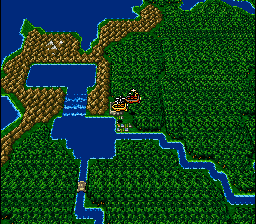 |
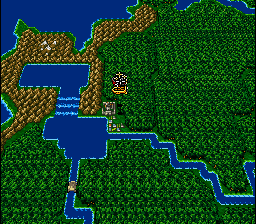 |
When Kain approaches the party at Baron and Toroia, his airship uses the standard design used by the Red Wings and Enterprise. When he takes the party to the Tower of Zot, however, it uses the design used by the Falcon.
Cid's Equipment
All of Cid's hammers do quadruple damage against machines, but no machines can be fought during his time in the party. Additionally, he can equip shields, but all of the weapons made available to him during his time in the party requires two hands to equip. This means that in order to equip a shield on Cid, one needs to forego a weapon entirely. Were the HandAxe mentioned above available at the time, it would be the only one-handed weapon he could equip, but it's still vastly inferior to the Wooden Hammer he comes equipped with.
Unlike the other characters that leave the party permanently, Cid's stats are saved up until the time FuSoYa departs for the Moon, at which point they are overwritten. This means that he may have been intended to rejoin the party at some point during development. If that were the case, then his hammers' anti-mech properties could come into play, and other one-handed axes would be available to him, since several are found after he leaves.
Daggers
Child Rydia and Edward can equip daggers, but there are no daggers obtainable when they are in your party. There is a glitch to get a Dancing Dagger early.
Cross in the Field
The Cross item, which cures curse in battle, can be selected in the field. This is pointless since curse status does not persist after battle.
Rydia Learns Cure2
When Rydia rejoins the party she automatically learns several spells, including Cure2. Rydia does not have a White magic command when she rejoins, so Cure2 can never be used.
Tower of Bab-il Leftovers
The Tower of Bab-il plays an important role in Final Fantasy IV's storyline, so maybe it's not surprising that it has more leftovers related to its maps than anywhere else in the game.
Overworld Entrance
First up, the tower is not accessible on the overworld because it's surrounded by a range of mountains and a ravine that the airship can't land in. Interestingly, though, two entrance triggers are placed on its base. Neither actually enter the tower, however. One leads to the Giant of Bab-il's mouth while the other leads to the airship map used in the game's introduction.
Additionally, the first overworld floor of the Tower of Bab-il map actually has an exit tile, which is inaccessible. This is just a "return" type exit, so it will just take the player back to whatever map they were last on.
Inaccessible Rooms
Anyone who's played through Final Fantasy IV knows that deep within the Tower of Bab-il exists a large Crystal Room, where all the crystals stolen by Golbez are kept. And anyone who's made it this far also knows that as soon as you set foot in this room, you trigger a hidden pit trap and fall to another section of the tower, never to return...
What most players don't know, however, is that this Crystal Room is not only fully intact, but there's actually something else beyond it, which can only be reached via a walk-through-walls code! The Crystal Room itself is arranged in a rather strange way, preventing access to the center of the room, and examining any of the crystals causes the game to crash rather spectacularly. Also, despite that you're never able to see it normally, the uppermost crystal chamber is empty. This actually makes perfect logical sense, as at that point in the game there's still one crystal Golbez has not obtained yet... though why this is represented in a room you can't see all of is a mystery.
Beyond the crystals, on the wall in the back of the room is a doorway, like the one in Mysidia's Crystal Room...
The door leads to a hallway behind the Crystal Room, which can be seen normally, but there's no legit way to reach it. There's nothing back here, however; while the door in the upper-left corner opens, it not only leads nowhere, but it also causes minor graphic glitches. There's also no way to get back into the Crystal Room once you're here, meaning you'd normally be trapped... but as the only way to get here is via a walk-through-walls code, this isn't much of an issue. Given the detail shown, these areas may have been explorable at some point in development, and it's likely the door would've led to additional floors of the tower, given the unused location data mentioned above.
"Rare" Underworld Encounters
There are four monsters that many players will never encounter. The first is the PinkPuff, which is understandable since it is an absurdly rare encounter in one room of the Lunar Subterrain. The other three, GlomWing, Crawler and Talantla, are actually very common encounters, the problem is they can only be fought on two tiny sections of the underworld map. These are the southern area of the landmass near the Sylvan Cave and a tiny peninsula south of that. Since there is no real reason to ever visit these areas, the monsters are missed.
Sylph's MP Cost
Most of the time when you have Rydia summon Sylph, her MP isn't decreased, despite the menu showing that 25 MP is needed to cast the spell. If you place Rydia in the first character slot (middle of the formation), however, 25 MP will be consumed from her as expected. That is, unless you hack the game to give the spell to Rydia while she's a child. The subroutine used by Sylph only deducts MP if the character casting the spell is in the first slot and only if that character is adult Rydia.
Dark Matter
In the original Japanese version, Edge can steal an event item called Dark Matter from Zeromus during the final battle. This item, long claimed to reduce the damage done by Zeromus' big bang attack, doesn't appear to actually do anything and is likely just an Easter egg.
The Final Fantasy series
| |
|---|---|
| NES | Final Fantasy (US Prototype) • Final Fantasy II (US Prototype) • Final Fantasy III |
| MSX2 | Final Fantasy |
| SNES | Final Fantasy IV • Final Fantasy V • Final Fantasy VI (US Prototype) |
| PlayStation | Final Fantasy IV • Final Fantasy V • Final Fantasy VI • Final Fantasy VII (Prototypes) • Final Fantasy VIII (Prototype) • Final Fantasy IX |
| PlayStation 2 | Final Fantasy X (Prototype) • Final Fantasy X-2 • Final Fantasy XII • Dirge of Cerberus: Final Fantasy VII |
| Game Boy Advance | Final Fantasy I & II: Dawn of Souls • Final Fantasy IV Advance • Final Fantasy V Advance • Final Fantasy VI Advance |
| Nintendo DS | Final Fantasy III • Final Fantasy IV |
| PlayStation Portable | Crisis Core: Final Fantasy VII • Final Fantasy Type-0 |
| Xbox 360 | Final Fantasy XIII (Prototype) • Lightning Returns: Final Fantasy XIII |
| PlayStation 3 | Final Fantasy XIII (Prototype) • Final Fantasy XIII-2 • Lightning Returns: Final Fantasy XIII |
| Wii | Final Fantasy IV: The After Years |
| Windows | Final Fantasy VII (Remake Intergrade) • Final Fantasy VIII • Final Fantasy X & X-2 HD Remaster • Final Fantasy XI • Final Fantasy XIII (Prototype) • Lightning Returns: Final Fantasy XIII • Final Fantasy XIV • Final Fantasy XIV Online: A Realm Reborn (Heavensward) • Final Fantasy XV Windows Edition • Final Fantasy II Pixel Remaster |
| PlayStation 4 | Final Fantasy XV • Final Fantasy VII Remake • Final Fantasy II Pixel Remaster |
| Nintendo Switch | Final Fantasy II Pixel Remaster |
| PlayStation 5 | Final Fantasy VII Remake Intergrade |
| iOS, Android | Lightning Returns: Final Fantasy XIII • Final Fantasy II Pixel Remaster |
| Tactics | |
| PlayStation | Final Fantasy Tactics |
| Game Boy Advance | Final Fantasy Tactics Advance |
| PlayStation Portable | Final Fantasy Tactics: The War of the Lions |
| Crystal Chronicles | |
| GameCube | Final Fantasy Crystal Chronicles |
| Nintendo DS | Final Fantasy Crystal Chronicles: Ring of Fates • Final Fantasy Crystal Chronicles: Echoes of Time |
| Wii | Final Fantasy Crystal Chronicles: Echoes of Time |
| Legend | |
| Game Boy | The Final Fantasy Legend • Final Fantasy Legend II • Final Fantasy Legend III |
| Dissidia | |
| PlayStation Portable | Dissidia Final Fantasy |
| PlayStation 4 | Dissidia: Final Fantasy NT |
| The Mystery Dungeon series | |
| PlayStation | Chocobo no Fushigina Dungeon • Chocobo's Dungeon 2 |
| Theatrhythm | |
| Nintendo 3DS | Theatrhythm Final Fantasy: Curtain Call |
| Spinoffs | |
| Game Boy | Final Fantasy Adventure |
| SNES | Final Fantasy: Mystic Quest |
| Nintendo DS | Final Fantasy Fables: Chocobo Tales |
| Related Games | |
| PlayStation | Ehrgeiz: God Bless the Ring • Vagrant Story |
| See Also | |
| Chrono Trigger/Cross • Kingdom Hearts • SaGa • World of Mana • Mystery Dungeon | |
- Featured articles
- Featured main articles
- Pages missing developer references
- Games developed by Square
- Games developed by TOSE
- Pages missing publisher references
- Games published by Square
- Games published by Squaresoft
- Games published by Square EA
- Games published by SCEE
- SNES games
- PlayStation games
- Pages missing date references
- Games released in 1991
- Games released in July
- Games released on July 19
- Games released in November
- Games released on November 23
- Games with unused areas
- Games with unused characters
- Games with unused code
- Games with unused enemies
- Games with unused graphics
- Games with unused items
- Games with unused text
- Games with regional differences
- Games with revisional differences
- Pages with a Data Crystal link
- Long pages to be condensed
- To do
- Final Fantasy series
Cleanup > Long pages to be condensed
Cleanup > Pages missing date references
Cleanup > Pages missing developer references
Cleanup > Pages missing publisher references
Cleanup > To do
Games > Games by content > Games with regional differences
Games > Games by content > Games with revisional differences
Games > Games by content > Games with unused areas
Games > Games by content > Games with unused characters
Games > Games by content > Games with unused code
Games > Games by content > Games with unused enemies
Games > Games by content > Games with unused graphics
Games > Games by content > Games with unused items
Games > Games by content > Games with unused text
Games > Games by content > Pages with a Data Crystal link
Games > Games by developer
Games > Games by developer > Games developed by Square Enix > Games developed by Square
Games > Games by developer > Games developed by TOSE
Games > Games by platform > PlayStation games
Games > Games by platform > SNES games
Games > Games by publisher > Games published by Electronic Arts
Games > Games by publisher > Games published by Sony > Games published by Sony Interactive Entertainment > Games published by Sony Computer Entertainment > Games published by SCEE
Games > Games by publisher > Games published by Square Enix > Games published by Square
Games > Games by publisher > Games published by Square Enix > Games published by Square > Games published by Square EA
Games > Games by publisher > Games published by Square Enix > Games published by Square > Games published by Squaresoft
Games > Games by release date > Games released in 1991
Games > Games by release date > Games released in July
Games > Games by release date > Games released in July > Games released on July 19
Games > Games by release date > Games released in November
Games > Games by release date > Games released in November > Games released on November 23
Games > Games by series > Final Fantasy series
The Cutting Room Floor > Featured articles
The Cutting Room Floor > Featured articles > Featured main articles

